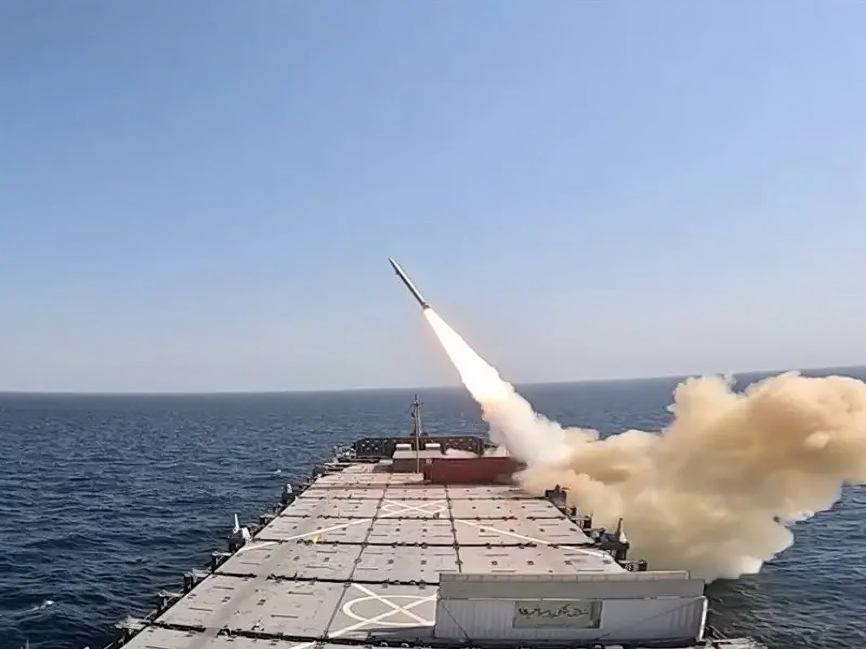Iran’s Islamic Revolutionary Guard Corps (IRGC) earlier this week announced firing a long-range ballistic missile from a warship for the first time.
IRGC Chief Maj Gen Hossein Salami said the test "was successfully carried out" in a joint effort by the Aerospace Force and Navy, the IRNA news agency reported on February 12.
"This new achievement has increased the range of our maritime influence and power to any point we want," he said.
He added that the IRGC's Navy defense and offensive power lies in the large number of drones, cruise and precision ballistic missiles capable of targeting warships.
“Nowhere is safe for those powers who seek to threaten our security,” Salami said in a thinly veiled threat to the United States and its allies, suggesting that Iran’s “ocean-liners” can get within range of any target.
On February 13, IRGC carried out an exercise simulating an attack on the mock-up of the Israeli airbase that supposedly houses F-35 fighter jets, using Emad and Qadr missiles. A new version of Emad missile, which uses liquid fuel and was equipped with enhanced warheads, hit the target from a distance of 1,700 km with an accuracy of less than four meters.
Earlier, the Iranian Army Ground Force's Airborne Force unveiled an upgraded version of the Shafaq heliborne anti-armour missile and the Yusef aerial camera, designed by experts in the force and Iranian knowledge-based companies.
The upgraded fire-and-forget type missile has an increased range of 20km and the new Yusef camera can operate in all weather conditions day and night, the Tasnim news agency reported on February 3.
This comes at a time when tensions have heightened in the region as the Iran-backed Yemeni Houthis have been targeting commercial vessels in the Red Sea, with ties to Israel or heading for Israeli ports, since the Israel-Gaza war started in October 2023. In response, the US and UK have carried out attacks on Houthi targets.
Iranian spy ship Behshad, which was reportedly providing intelligence to the Houthis, left the Red Sea and docked off the coast from a Chinese military base in Djibouti in early February. Meanwhile, the Iranian Navy's 94th combat flotilla, led by the Alborz destroyer, returned to the country after finishing its mission in the Red Sea and the Gulf of Aden on February 10.
“The continuous presence of Iran's Navy in the Red Sea and the Gulf of Aden provided intelligence and operational command for the country and praised the role of the 94th flotilla in escorting Iranian merchant ships and oil tankers through those waterways,” Iran's Southern Fleet commander, Rear Adm Hossein Hassani, said at the homecoming ceremony welcoming the ships' personnel at a naval harbour in the southern province of Hormozgan.
Since the onset of war in Gaza, Iranian-allied militias known as the “Axis of Resistance” have stepped up operations from multiple fronts in the Middle East against US and Israeli-linked entities.
Around 170 attacks by Iran's proxies on US forces have not altered that US policy – not even after a drone strike in Jordan on January 28 that killed three American soldiers and wounded over 30. The US-Iran confrontation has not touched Iranian territory so far, and Washington has signalled it does not intend to strike Iran directly.
In recent years, Iranian military experts and technicians have achieved self-sufficiency in domestically producing a wide array of equipment, making significant strides in the realm of weaponry. The IRGC’s Aerospace Department is credited with developing the new missile and the bulk of Iran's missile program.
Iranian officials consistently assert that their missile program is for deterrence, emphasizing their commitment to enhancing military capabilities, including missile and drone technology, despite Western sanctions and opposition from Israel.
Prior to Iran's recent ballistic missile test, Iran’s former head of the Atomic Energy Organization, Ali-Akbar Salehi, signaled that his country was closer than ever to a nuclear weapon.
Iranian officials have always insisted that the country’s nuclear program is peaceful, but experts including the head of the UN nuclear watchdog say enriching uranium to such levels as Iran has done cannot be justified or even explained by peaceful intentions.
In a December report, the International Atomic Energy Agency (IAEA) noted that Iran is now producing approximately nine kilograms of uranium enriched to 60 percent uranium-235 per month. Iran was producing 60 percent enriched U-235 at a similar rate in early 2023 but decreased production by about two-thirds in June.
Accelerating the production of uranium enriched to 60 percent U-235 is concerning because the material can be quickly enriched to weapons-grade levels or 90 percent.







 Kyrgyzstan has joined the extensive reconstruction efforts in the Karabakh region of Azerbaijan, after a series of mega initiatives were launched b...
Kyrgyzstan has joined the extensive reconstruction efforts in the Karabakh region of Azerbaijan, after a series of mega initiatives were launched b...
 President Ilham Aliyev shed light on the evolving contours of the peace process with Armenia during an international conference in Baku this week. ...
President Ilham Aliyev shed light on the evolving contours of the peace process with Armenia during an international conference in Baku this week. ...
 Azerbaijan and Armenia started the process of demarcation of their border on Tuesday, with the installation of the first border markers based on ge...
Azerbaijan and Armenia started the process of demarcation of their border on Tuesday, with the installation of the first border markers based on ge...
 Iran and Pakistan have signed eight cooperation documents in various fields, and agreed to strengthen ties to fight terrorism in the region.
Iran and Pakistan have signed eight cooperation documents in various fields, and agreed to strengthen ties to fight terrorism in the region.
 As the conflict between Ukraine and Russia escalates, the strategic importance of Kharkiv, Ukraine's second-largest city, has come sharply into focus.
As the conflict between Ukraine and Russia escalates, the strategic importance of Kharkiv, Ukraine's second-largest city, has come sharply into focus.



